|
|
|
|
|

Detail
of an Admiralty chart, showing Scapa Flow and the
surrounding Orkney islands. This chart was updated
in 1924 when Cox began salvage operations and shows
the positions of the many wrecks he raised. Lyness,
on the island of Hoy, where Cox based his salvage
operations is far left. (Courtesy
- UK Hydrographic Office)
|
|
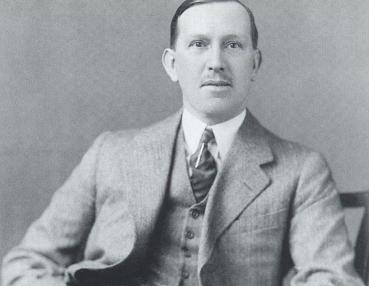
Ernest Cox poses for a London
photographer, immaculately dressed as always,
even when at work in the filth and squalor of
a sunken warship. He later said, "Without
boasting, I do not think there is another man in the
world who could have tackled the same job. Before I
undertook this formidable task, I had never raised a
ship in my life. Quite frankly, experts thought me
crazy, but to me these vessels represented nothing
more than so much scrap of brass, gunmetal, bronze,
steel etc., and I was determined to recover this at
all costs." (Courtesy - the Cox Family)
|
|
|
|
|
|
|
|
|
|

The German Imperial High Seas Fleet
interned in Scapa after the armistice in November
1918. Vice Admiral Ludwig von Reuter ordered their
crews to scuttle all seventy-four vessels rather
than hand them over to the Royal Navy. Here a Royal
Navy guard threatens a destroyer captain at gunpoint
to stop him from sinking his vessel. Altogether nine
unarmed German sailors were killed and fourteen
injured when the Royal Navy shot them, making these
victims the last casualties of the First World War.
|
|

The
fast minelayer Bremse was one of the ships that the
Royal Navy tried to save when the fleet was
scuttled; to no avail. She ended up like this,
capsized and partially beached in Swanbister Bay on
the main Orkney island of Pomona.
|
|
|
|
|
|
|
|
|
|

Looking
down a line of winches aboard one of Cox's floating
docks. The winches can be seen clearly in the
foreground where teams of men literally heaved a
sunken warship to the surface. The technique became
known as 'heaving twenties' because the men could
only turn their handles twenty times before needing
a rest.
|
|

A raised destroyer between the floating
docks during the 1920s, having just been dropped in
Mill Bay. Smit Salvage of Rotterdam used a similar
method nearly eighty years later to raise the
Russian nuclear submarine, Kursk, in 2001.
|
|
|
|
|
|
|
|
|
|

Two
beached destroyers waiting to be broken up in Mill
Bay. It took about one month to reduce them to scrap
metal. Each ship was methodically stripped down to
allow the vessel to float further up the beach on
the next high tide to be further broken up until
nothing was left.
|
|
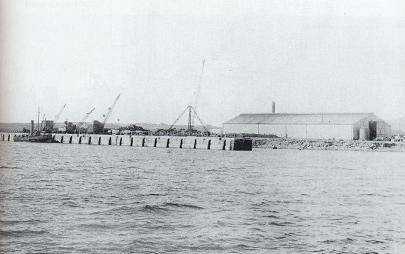
Lyness Pier as it was in the 1920s when
the salvage operations were well under way. Mill Bay
where the vessels were broken up, is on the right
and Ore Bay is to the left. The large crane that
killed Donald Henderson (a salvage labourer) is
in the centre.
|
|
|
|
|
|
|
|
|
|

'Lyness Pier 24/6/25.' This picture is
dated four days after Henderson was killed when a
100ft jib collapsed on top of him. The crowds of men
on the pier are preparing to attend his funeral.
Loose wires can still be seen hanging down from
where the jib once stood. Cox's white pinnace is
moored alongside. She was named Bunts, after his
daughter, and no doubt conveyed him to Lyness Pier
for the funeral.
|
|
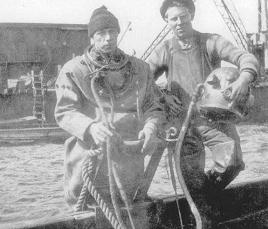
Sandy
Robertson (right) working as a diver's assistant to
Sinclair (Sinc) Mackenzie, standing on the ladder.
Sandy helped save Sinc's life after an accident on
the Von der Tann as well as that of Thomas McKenzie.
Sinc Mackenzie was the last diver to detect life
aboard the doomed submarine HMS Thetis in 1939. (Courtesy
- Sandy Robertson)
|
|
|
|
|
|
|
|
|
|

The
Hindenburg heeling over to starboard on the first
attempt at raising her in 1926. Jenny Jack, Cox's
wife, is standing centre, facing the camera. A storm
is beginning to blow up that eventually led to Cox
losing the fight to raise her - this time.
|
|

The storm that sank the Hindenburg on
the first attempt to raise her in 1926 as the waves
lashed the men and vessels trying to keep her
afloat. Cox's floating dock was holed, his pumps had
failed and his men were exhausted, but still he
fought the storm to hold on to his ship.
|
|
|
|
|
|
|
|
|
|

Ernest
Cox, immaculately dressed as always, looking very
pleased as he stands on the bottom of a salvaged
warship.
|
|
 Jim
Southerland climbs down an airlock on his way to
work. The hatch was closed behind him and he climbed
down to the bottom hatch, knocking on it to let the
men inside her know that he was there. The airlock
was then pressurized to equal the air pressure
inside the compartment, and Jim would climb through
for his eight-hour shift. Jim
Southerland climbs down an airlock on his way to
work. The hatch was closed behind him and he climbed
down to the bottom hatch, knocking on it to let the
men inside her know that he was there. The airlock
was then pressurized to equal the air pressure
inside the compartment, and Jim would climb through
for his eight-hour shift.
|
|
|
|
|
|
|
|
|
|

The
24,000-ton upturned battleship Kaiser shortly after
breaking the surface in March 1929. Men had to gain
access to the sunken warships' hulls through
airlocks. The four airlocks needed to enter and
prepare the Kaiser can be clearly seen here, looking
more like ships' funnels. In order to reach a sunken
ship, some of Cox's crudely built airlocks were 60ft
high.
|
|

The capsized Moltke en route to Rosyth,
surrounded by tugs. Through a misunderstanding two
pilots were appointed to guide her to the dry dock.
An argument over who should command her led to the
Moltke being cast off as she headed for the Forth
Bridge's central pillar, completely unassisted. The
temporary housing for men and machines while on the
journey was built on the ship's bottom, which was
now her top.
|
|
|
|
|
|
|
|
|
|

Adolph Hitler came to power a few
months before the Von der Tann was towed to Rosyth.
The Nazi Swastika flies over the tugboat Parnass on
the von der Tann's starboard side. Many sightseers
were in Rosyth to see Cox deliver his last salvaged
German warship. They were also among the first to
see this Nazi emblem in British waters, which six
years later would be a common symbol of evil
throughout the free world.
|
|

The
Seydlitz weathering the storm that struck while she
was being towed to Rosyth. She arrived there despite
the loss of both equipment and supplies in the
raging seas. (One of the passage or runner crew
circled)
|
|
|
|
|
|
|
|
|
|
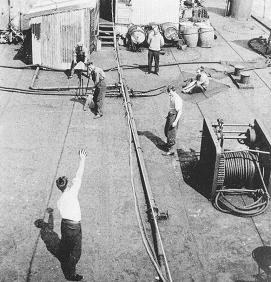
A
'runner crew' of eleven to fourteen men took the
salvaged vessels the 270 miles from Scapa Flow to
Rosyth. In good conditions they could play cricket
on board, but they also weathered some terrifying
gales.
|
|

The runner crew aboard the Prinzregent
Luitpold pose for a picture in front of the
corrugated iron kitchen named the Hotel Metropole,
built on the upturned hull. Their sense of humour
could be seen everywhere. The mess and bunkhouse
were the Apartments de Luxe. The notice to the left
reads 'Honeymoons arranged, spring mattresses fitted
with speedometers. First aid equipment in all rooms.
Second class rooms no spring mattresses.' The menu
on the right reads, 'Boiled Luitpold with knobs on',
'Scapa salvage stew' with 'dock broth', Reporter
James Lewthwaite of the Daily Mail is in the centre
of the back row.
|
|
|
|
|
|
|
|
|
|

The Seydlitz in her dry dock, ready for
breaking up. A sad end for a battle cruiser that
survived the Battle of Jutland and got back safely
to Germany in spite of damage from twenty-three
direct shell hits and a torpedo strike.
|
|

All the German warships salvaged in
Scapa Flow met the same fate. Sometimes their armour
plate was as much as 12in thick and was a great
source of revenue. Here a burner cuts the armour
plate into convenient chunks to fit into a furnace.
Behind him are propeller blades, which were also a
highly prized commodity from the wrecks.
|
|
|
|
|
|
|
|
|
|

Cutting up Moltke. A burner at work.'
With no Health and Safety regulations, the burner,
with a cigarette in his mouth, cuts up the battle
cruiser with an oxy-acetylene torch. He was breaking
no rules in the 1920s as he stripped away metal to
lighten her for the voyage to Rosyth.
|
|
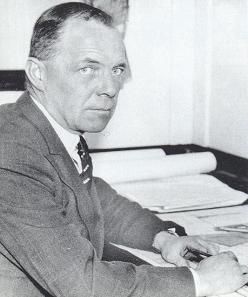
Thomas
McKenzie (Chief Salvage Officer) working at
his desk, probably aboard the salvage vessel Bertha,
after Cox left Scapa Flow and Metal Industries took
over. In June 1939 McKenzie led a team of salvage
divers to help rescue ninety-nine submariners
trapped aboard the sunken submarine HMS Thetis,
which ended in tragedy after his offer of help was
accepted too late. When the Second World War began,
like many of the Scapa Flow team, McKenzie worked
for the Admiralty Salvage Department, which
distinguished itself during the Battle of the
Atlantic and from D-Day onwards in Northern Europe.
He was eventually awarded the CBE and CB for his
work.
|